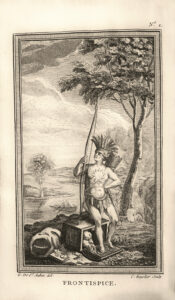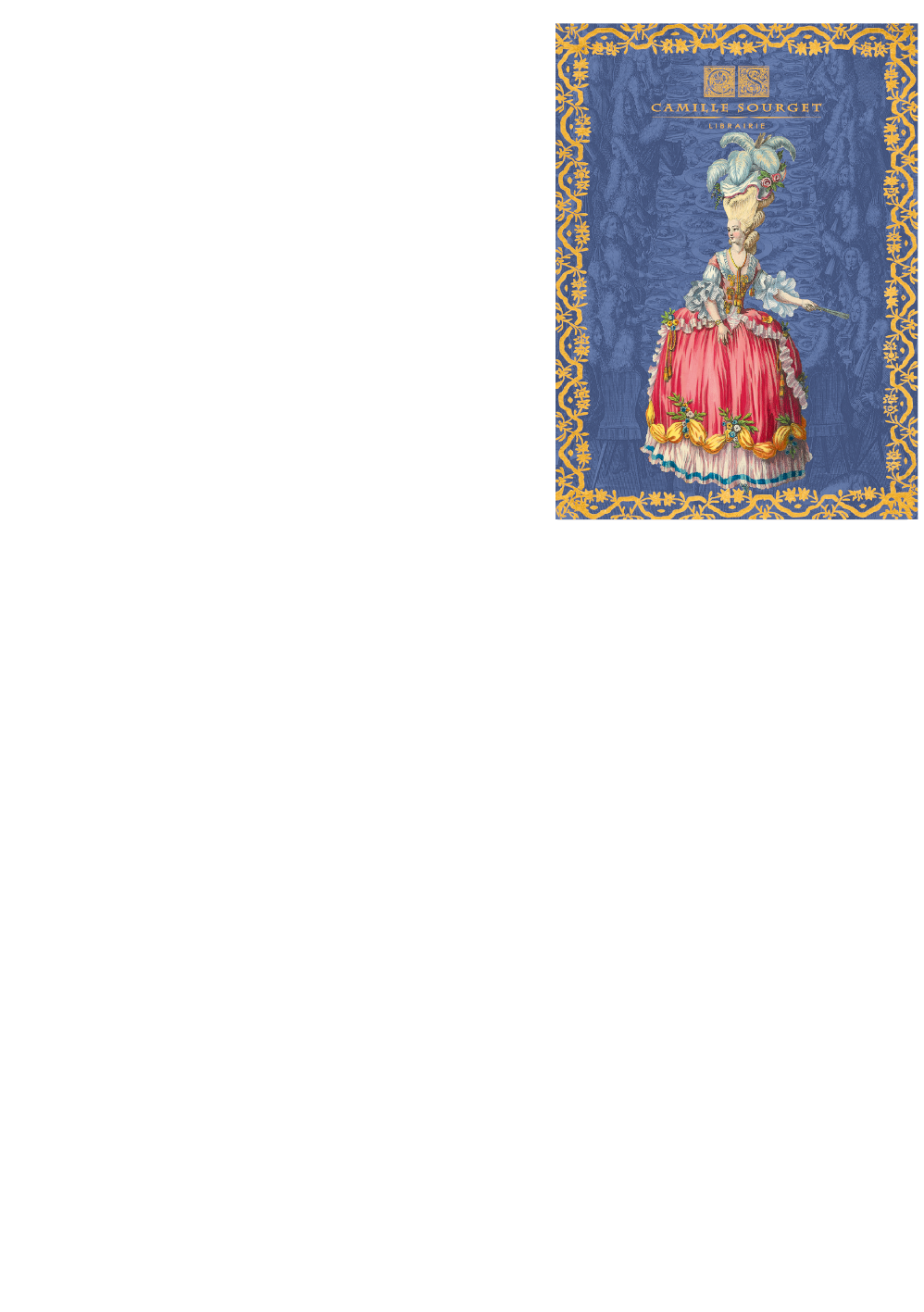Paris, Le Jay, 1768.
2 parties en 1 volume in-12 de : pp. xx, 244 ; titre, 264 pp. 4 planches. Veau marbré, dos à nerfs orné, tranches rouges. Reliure de l’époque.
163 x 94 mm.
Edition originale rare illustrée de deux frontispices et de 2 planches hors texte de Saint Aubin gravées par Beurlier.
Howgego I,138(B138) ; Sabin 6465 ; JCB I (III-I) 1611 ; Howes B626 ; Streeter 15187 ; Clark, Old South II, 5 ; Field 156 ; Rader 408 ; Monaghan 261 ; Hubach p. 13 ; Storm, De Graff 361 ; Eberstadt 131:84 ; Siebert 677 ; Leclerc I, 185. Cf. Servies, Florida 491 : the English edition of 1771.
« Le Chevalier Bossu est un de ceux qui ont le mieux fait connaître la Louisiane, et les peuples sauvages qui l’habitaient. Il fut envoyé dans ce pays en 1750, et nommé à cette époque Capitaine de la Marine… » (Chadenat 23).
First edition, of primary interest for Louisiana, Alabama, Illinois, and West Florida.
Jean Bernard Bossu (1720-1792), a captain in the French navy, was the first to write about eighteenth-century Louisiana in detail and based on personal experience. He provided the French public with the earliest trustworthy description of the people and conditions in the colony. The work is actually a collection of 21 letters he wrote during his first two voyages to the country, in 1751-57 and 1757-62. Bossu traveled as far north as Fort de Chartres, just south of Saint Louis. He spent time with the Natchez, Arkansas, Koakias (Cherokees?), Alabama, Choctaw, Illinois and Atakapa tribes, providing substantial information on their habits in religion, warfare, social customs (e.g.punishment for adultery), hunting, and more. He also comments on Santo Domingo, mining, Syphilis, Havana, New Orleans, Hernando de Soto, El Dorado, the Sieur de La Salle, Granada, Jamaica, Lake Ponchartrain, Mobile and the Fountain of Youth. Occasionally he ranges even further afield, describing the skeletons of elephants (i.e., mastodons) found in the Ohio Valley in 1735 (p. 206). At second hand, he reports on events in Canada such as the capture by Montcalm of Fort Oswego, Fort Ontario and New Fort Oswego in 1756. In Book Il, Lettre XXI, Bossu speculates that the lndians reached America via a land bridge from Tartary, referring to the works of Diodorus Siculus, Peter Martyr, Lafitau, Lescarbot, and Bering. In the course of his travels Bossu was shipwrecked, had a close escape from a crocodile, and ran afoul of English corsairs several times. The four engravings by Gabriel de Saint Aubin all show Indians; among them are a gruesome decapitation and an Indian who stands on an overturned chest full of coins. The first edition of this work is distinguished from the second edition, with the same imprint and date, by its lack of the words « second edition » on the title. Howes notes, « For comments too critical of the ministry, Bossu was imprisoned and his book banned for a while in France ; this probably accounts for the scarcity of the first edition, of which Sabin found no record. » The Nouveaux voyages was soon translated to English, Dutch, Germain, and Russian.
Bel exemplaire en reliure de l’époque.

![Nouveaux voyages aux Indes Occidentales ; Contenant une Relation des differens Peuples qui habitent les environs du grand Fleuve Saint-Louis, appellé vulgairement le Mississipi ; leur Religion, leur gouvernement, leurs mœurs [sic] ; leurs guerres & leur commerce. Par M. Bossu, Capitaine dans les Troupes de la Marine.](https://www.camillesourget.com/wp-content/uploads/2025/07/DSC_3950-scaled.jpg)
![Nouveaux voyages aux Indes Occidentales ; Contenant une Relation des differens Peuples qui habitent les environs du grand Fleuve Saint-Louis, appellé vulgairement le Mississipi ; leur Religion, leur gouvernement, leurs mœurs [sic] ; leurs guerres & leur commerce. Par M. Bossu, Capitaine dans les Troupes de la Marine. – Image 2](https://www.camillesourget.com/wp-content/uploads/2025/07/DSC_3951-scaled.jpg)
![Nouveaux voyages aux Indes Occidentales ; Contenant une Relation des differens Peuples qui habitent les environs du grand Fleuve Saint-Louis, appellé vulgairement le Mississipi ; leur Religion, leur gouvernement, leurs mœurs [sic] ; leurs guerres & leur commerce. Par M. Bossu, Capitaine dans les Troupes de la Marine. – Image 3](https://www.camillesourget.com/wp-content/uploads/2025/07/DSC_3952-scaled.jpg)
![Nouveaux voyages aux Indes Occidentales ; Contenant une Relation des differens Peuples qui habitent les environs du grand Fleuve Saint-Louis, appellé vulgairement le Mississipi ; leur Religion, leur gouvernement, leurs mœurs [sic] ; leurs guerres & leur commerce. Par M. Bossu, Capitaine dans les Troupes de la Marine. – Image 4](https://www.camillesourget.com/wp-content/uploads/2025/07/DSC_3954-CUT-scaled.jpg)
![Nouveaux voyages aux Indes Occidentales ; Contenant une Relation des differens Peuples qui habitent les environs du grand Fleuve Saint-Louis, appellé vulgairement le Mississipi ; leur Religion, leur gouvernement, leurs mœurs [sic] ; leurs guerres & leur commerce. Par M. Bossu, Capitaine dans les Troupes de la Marine. – Image 5](https://www.camillesourget.com/wp-content/uploads/2025/07/DSC_3954-scaled.jpg)
![Nouveaux voyages aux Indes Occidentales ; Contenant une Relation des differens Peuples qui habitent les environs du grand Fleuve Saint-Louis, appellé vulgairement le Mississipi ; leur Religion, leur gouvernement, leurs mœurs [sic] ; leurs guerres & leur commerce. Par M. Bossu, Capitaine dans les Troupes de la Marine. – Image 6](https://www.camillesourget.com/wp-content/uploads/2025/07/DSC_3958-scaled.jpg)
![Nouveaux voyages aux Indes Occidentales ; Contenant une Relation des differens Peuples qui habitent les environs du grand Fleuve Saint-Louis, appellé vulgairement le Mississipi ; leur Religion, leur gouvernement, leurs mœurs [sic] ; leurs guerres & leur commerce. Par M. Bossu, Capitaine dans les Troupes de la Marine. – Image 7](https://www.camillesourget.com/wp-content/uploads/2025/07/reliureCUT-scaled.jpg)
